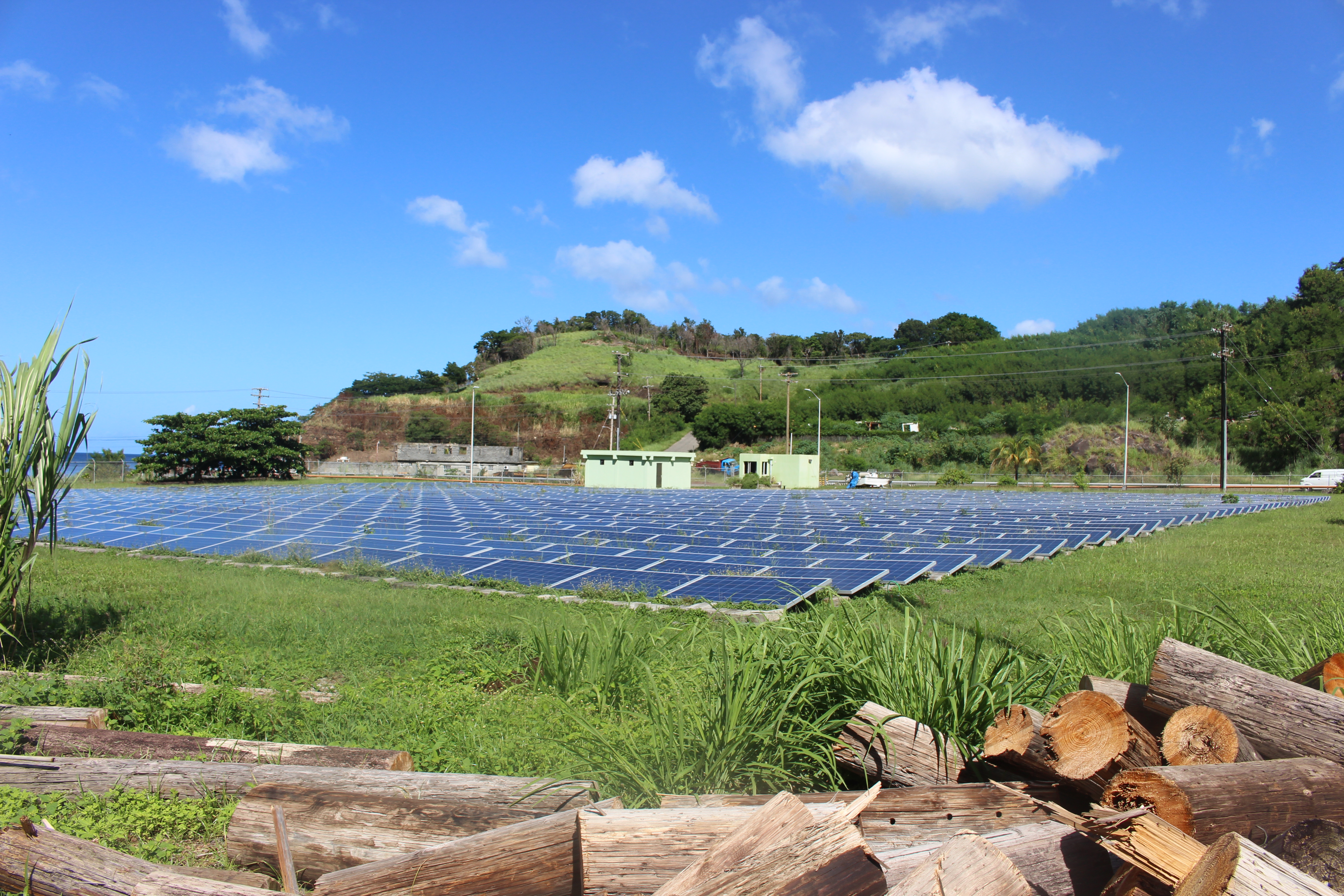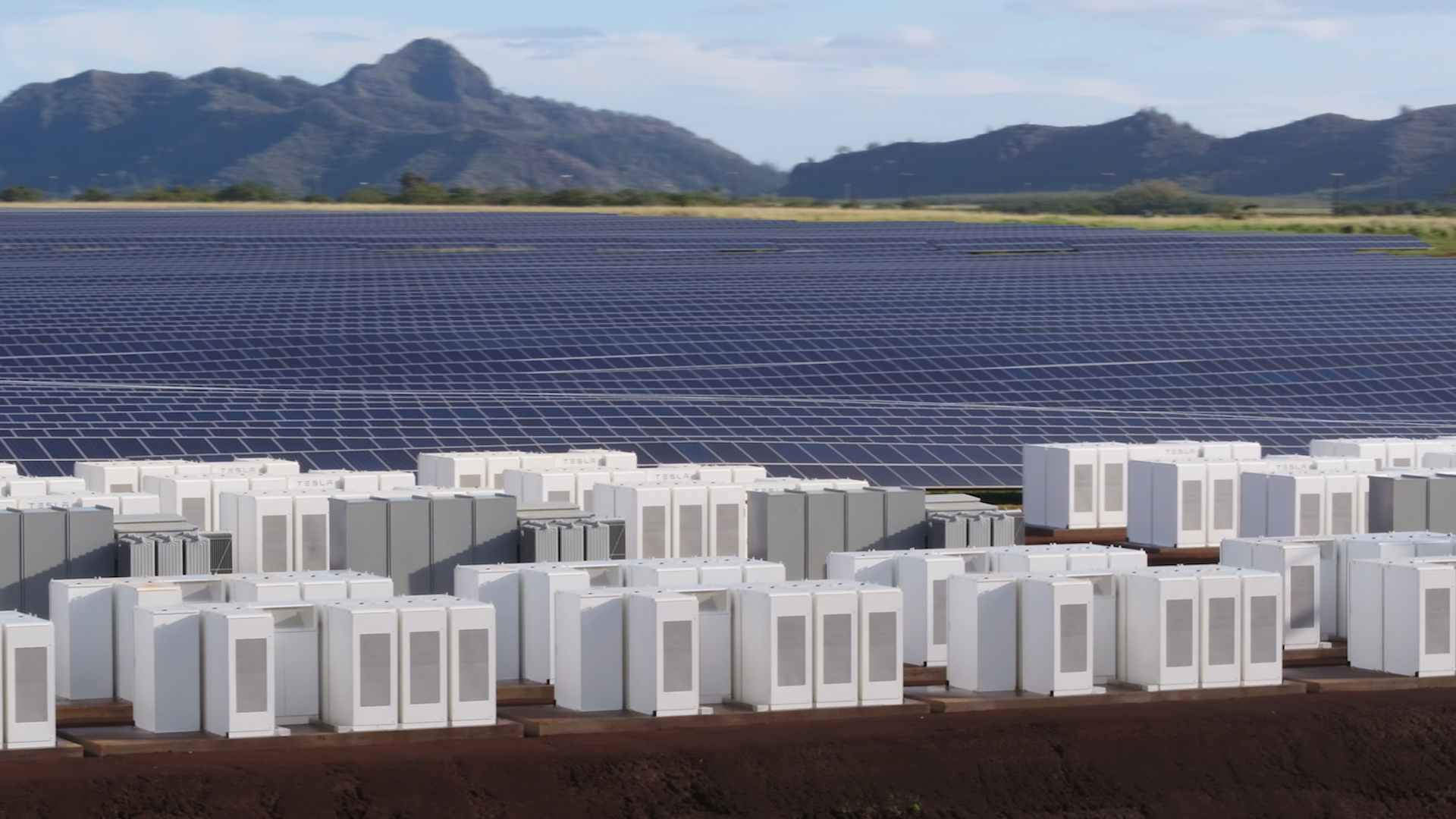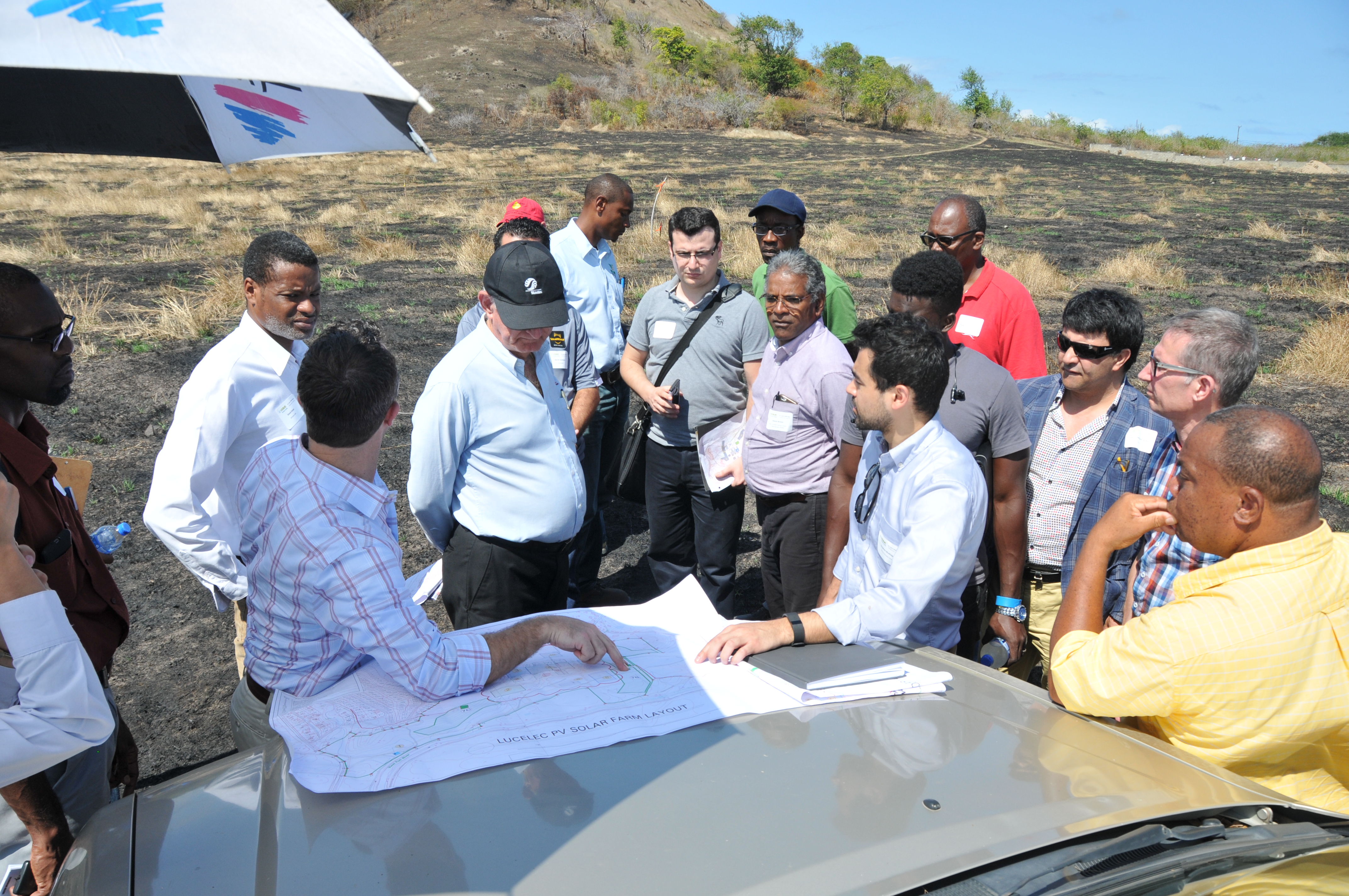Islands of opportunity
The article below was printed in the August 2017 edition of PV Magazine. An online archive can be found on the pv magazine website.
[caption id="attachment_3502" align="alignnone" width="5184"] The St. Vincent's utility, VINLEC, installed and operates a 500 kW solar system near Lowmann's Bay Power Station. Source: RMI.[/caption]
The St. Vincent's utility, VINLEC, installed and operates a 500 kW solar system near Lowmann's Bay Power Station. Source: RMI.[/caption]
Despite being at the highest risk of climate change impacts, island nations are emerging as renewable energy champions. Solar and storage have hit an inflection point against diesel generation offering lower cost, cleaner electricity to island nations.
As a group, island nations have contributed less than 1% of global emissions, yet they are among the most vulnerable regions to climate change. Rising sea levels and disruption to ocean ecosystems represent some of the main threats to island communities.
Through the adoption of renewable energy, island countries are becoming leaders on climate change. Of the first 15 states to ratify the Paris agreement on the day it was signed, 13 of those countries were island nations.
For most small islands developing states (SIDS), renewable energy also provides a foundation for economic development through cheaper, more reliable sources of energy.
SIDS represents a grouping of island countries and territories in the Caribbean, the Pacific and off the coasts of Africa and Asia. Given the remote nature of these islands, about 85% of SIDS electricity generation comes from imported fossil fuels, primarily diesel. The electricity that comes from these imported fossil fuels is expensive. On average, the price of electricity on island nations is $0.35 per kWh but can be as high as $0.50 per kWh.
Fortuitously, most SIDS have abundant sources of renewable energy including solar, wind, geothermal, and hydropower. As most islands often have a combination of each renewable energy source, there is scope to manage the intermittency of renewables like solar and wind power through multiple energy sources. Even in places that are not rich in multiple energy sources, the existing diesel generators are much more flexible than base-load coal and nuclear plants. Beyond flexible generators, as the price of energy storage has dramatically declined, there has been increasing levels of energy storage deployment in island communities offering “firm” solar and wind generation.
[caption id="attachment_3503" align="alignnone" width="1920"] The solar and storage project developed by Tesla Energy on Kauai Island in Hawaii consists of 13 MW of solar and 52 MWh of storage. Under the 20-year contract, the Kauai Island Utility purchases electricity at $0.14 per kWh. Source: Tesla.[/caption]
The solar and storage project developed by Tesla Energy on Kauai Island in Hawaii consists of 13 MW of solar and 52 MWh of storage. Under the 20-year contract, the Kauai Island Utility purchases electricity at $0.14 per kWh. Source: Tesla.[/caption]
Island opportunities
Many energy companies have already begun capitalizing on the opportunity for renewable energy and energy storage deployment on island countries.
According to an analysis by Bloomberg New Energy Finance, from 2016 to the first quarter of 2017, Tesla Energy deployed 63 MWh of storage on islands representing 36% of its total storage deployment during that time.
Lyndon Rive, a cofounder of Solar City and former President of global sales at Tesla Energy, said at the Energy Storage Association conference in April 2017 that "it makes perfect sense to convert every island out there right now to solar and storage. We are doing that." Rive went on to say, “we don't see inflection points so often, and last year was the inflection point for solar and storage in any market that uses diesel."
As if to vindicate Rive’s bullish sentiment on the economics of solar and storage, many market leaders in diesel generators have recently signed partnerships with or acquired battery storage companies. The most recent acquisition occurred last month when Aggreko acquired Younicos, and only a few months before, Wartsila acquired Greensmith.
While solar and storage have definitively gained the upper hand over diesel generators, the deployment of solar and storage has been slowed by a lack of knowledge and skills in island governments and utilities.
[caption id="attachment_media-25" align="alignnone" width="4288"] In partnership with the St. Lucia government and utility, RMI conducts a site walk with interested bidders for the 3MW solar park in St. Lucia. Source: RMI.[/caption]
In partnership with the St. Lucia government and utility, RMI conducts a site walk with interested bidders for the 3MW solar park in St. Lucia. Source: RMI.[/caption]
Building the skills
Despite the high cost of imported diesel, island governments and utilities often do not know they can save with solar and storage or do not know how to integrate these renewable resources into the existing grid.
Organizations like the Rocky Mountain Institute (RMI) are working with island governments, utilities, developers, and citizens to accelerate the transition to renewable energy. Through the support of the Global Environment Facility in partnership with the United Nations Development Program, RMI’s engagement with island nations often starts by constructing energy transition plans that allow government and utilities to understand how they can leverage renewables to lower costs, reduce price volatility, and increase grid stability.
Throughout their engagement with island stakeholders, RMI provides training, webinars, and conferences to develop the local skill-base to ensure long-term renewable energy deployment. To further build local capacity, RMI along with several other organizations have worked with the Caribbean Electric Utility Services Corporation (CARILEC) to develop an online information-sharing platform where utilities, governments, and developers from across the region can ask questions and share information. Recent posts on the platform have discussed hurricane preparedness strategy, energy storage deployment, and the Caribbean Development Bank’s public-private partnership toolkit.
In addition to planning and capacity building, RMI also works with stakeholders to de-risk project tenders. RMI is in the process of supporting the development of several projects in the eastern Caribbean, which includes a 3 MW solar plant on St. Lucia, a total of 1 MW of solar PV spread across several islands in Turks and Caicos, and a 150 kW-250kWh solar-storage project on Mayreau Island in St. Vincent and the Grenadines. The solar-storage project on Mayreau Island will provide 50% of total energy production. All the projects will be owned and operated by the island utilities.
Chris Burgess, Director of Projects at RMI, spoke with pv magazine while on Mayreau island after giving a site tour to prospective developers. “While diesel generators have been the long-standing source of power for these islands, renewable energy can lower costs and reduce price volatility. All of the projects we have helped develop deliver a 15 - 30% cost reduction to the utilities owning and operating these systems.”
[caption id="attachment_3505" align="alignnone" width="5312"] Mayreau Island depends on costly imported diesel. In preparation of 150kW-250 kWh solar-storage system, RMI and local contractors are performing preparations for a pull test to determine foundation type on site. Source: RMI.[/caption]
Mayreau Island depends on costly imported diesel. In preparation of 150kW-250 kWh solar-storage system, RMI and local contractors are performing preparations for a pull test to determine foundation type on site. Source: RMI.[/caption]
Not all islands have pursued a utility-centered approach to solar deployment. Mauritius, off the eastern coast of Madagascar, just launched the second phase of its small-scale, distributed generation net-metering scheme. The scheme covers a total of 2 MW of capacity made up of individual systems less than 5 kW. Phase one concluded at the end of 2016 after deploying 5 MW of distributed PV.
Regardless of the size or character of the renewable deployment, islands are at the frontlines of climate change and renewable energy deployment.
When asked what the experience of island nations can teach other countries, Stephen Doig, Managing Director of the RMI, told pv magazine, “The experience of islands shows that high renewable penetrations (over 30%) are possible even in isolated systems and even higher penetrations can be achieved if load balancing and firm renewables are available. The transition to renewables is cost effective even in an era of lower cost fossil fuels.”
The deployment success of renewable energy developers and acquisitions by diesel generator incumbents indicates that a true inflection point has been reached. Through these opportunities, island nations are fighting climate change by becoming renewable energy champions.
[caption id="attachment_3502" align="alignnone" width="5184"]
 The St. Vincent's utility, VINLEC, installed and operates a 500 kW solar system near Lowmann's Bay Power Station. Source: RMI.[/caption]
The St. Vincent's utility, VINLEC, installed and operates a 500 kW solar system near Lowmann's Bay Power Station. Source: RMI.[/caption]Despite being at the highest risk of climate change impacts, island nations are emerging as renewable energy champions. Solar and storage have hit an inflection point against diesel generation offering lower cost, cleaner electricity to island nations.
As a group, island nations have contributed less than 1% of global emissions, yet they are among the most vulnerable regions to climate change. Rising sea levels and disruption to ocean ecosystems represent some of the main threats to island communities.
Through the adoption of renewable energy, island countries are becoming leaders on climate change. Of the first 15 states to ratify the Paris agreement on the day it was signed, 13 of those countries were island nations.
For most small islands developing states (SIDS), renewable energy also provides a foundation for economic development through cheaper, more reliable sources of energy.
SIDS represents a grouping of island countries and territories in the Caribbean, the Pacific and off the coasts of Africa and Asia. Given the remote nature of these islands, about 85% of SIDS electricity generation comes from imported fossil fuels, primarily diesel. The electricity that comes from these imported fossil fuels is expensive. On average, the price of electricity on island nations is $0.35 per kWh but can be as high as $0.50 per kWh.
Fortuitously, most SIDS have abundant sources of renewable energy including solar, wind, geothermal, and hydropower. As most islands often have a combination of each renewable energy source, there is scope to manage the intermittency of renewables like solar and wind power through multiple energy sources. Even in places that are not rich in multiple energy sources, the existing diesel generators are much more flexible than base-load coal and nuclear plants. Beyond flexible generators, as the price of energy storage has dramatically declined, there has been increasing levels of energy storage deployment in island communities offering “firm” solar and wind generation.
[caption id="attachment_3503" align="alignnone" width="1920"]
 The solar and storage project developed by Tesla Energy on Kauai Island in Hawaii consists of 13 MW of solar and 52 MWh of storage. Under the 20-year contract, the Kauai Island Utility purchases electricity at $0.14 per kWh. Source: Tesla.[/caption]
The solar and storage project developed by Tesla Energy on Kauai Island in Hawaii consists of 13 MW of solar and 52 MWh of storage. Under the 20-year contract, the Kauai Island Utility purchases electricity at $0.14 per kWh. Source: Tesla.[/caption]Island opportunities
Many energy companies have already begun capitalizing on the opportunity for renewable energy and energy storage deployment on island countries.
According to an analysis by Bloomberg New Energy Finance, from 2016 to the first quarter of 2017, Tesla Energy deployed 63 MWh of storage on islands representing 36% of its total storage deployment during that time.
Lyndon Rive, a cofounder of Solar City and former President of global sales at Tesla Energy, said at the Energy Storage Association conference in April 2017 that "it makes perfect sense to convert every island out there right now to solar and storage. We are doing that." Rive went on to say, “we don't see inflection points so often, and last year was the inflection point for solar and storage in any market that uses diesel."
As if to vindicate Rive’s bullish sentiment on the economics of solar and storage, many market leaders in diesel generators have recently signed partnerships with or acquired battery storage companies. The most recent acquisition occurred last month when Aggreko acquired Younicos, and only a few months before, Wartsila acquired Greensmith.
While solar and storage have definitively gained the upper hand over diesel generators, the deployment of solar and storage has been slowed by a lack of knowledge and skills in island governments and utilities.
[caption id="attachment_media-25" align="alignnone" width="4288"]
 In partnership with the St. Lucia government and utility, RMI conducts a site walk with interested bidders for the 3MW solar park in St. Lucia. Source: RMI.[/caption]
In partnership with the St. Lucia government and utility, RMI conducts a site walk with interested bidders for the 3MW solar park in St. Lucia. Source: RMI.[/caption]Building the skills
Despite the high cost of imported diesel, island governments and utilities often do not know they can save with solar and storage or do not know how to integrate these renewable resources into the existing grid.
Organizations like the Rocky Mountain Institute (RMI) are working with island governments, utilities, developers, and citizens to accelerate the transition to renewable energy. Through the support of the Global Environment Facility in partnership with the United Nations Development Program, RMI’s engagement with island nations often starts by constructing energy transition plans that allow government and utilities to understand how they can leverage renewables to lower costs, reduce price volatility, and increase grid stability.
Throughout their engagement with island stakeholders, RMI provides training, webinars, and conferences to develop the local skill-base to ensure long-term renewable energy deployment. To further build local capacity, RMI along with several other organizations have worked with the Caribbean Electric Utility Services Corporation (CARILEC) to develop an online information-sharing platform where utilities, governments, and developers from across the region can ask questions and share information. Recent posts on the platform have discussed hurricane preparedness strategy, energy storage deployment, and the Caribbean Development Bank’s public-private partnership toolkit.
In addition to planning and capacity building, RMI also works with stakeholders to de-risk project tenders. RMI is in the process of supporting the development of several projects in the eastern Caribbean, which includes a 3 MW solar plant on St. Lucia, a total of 1 MW of solar PV spread across several islands in Turks and Caicos, and a 150 kW-250kWh solar-storage project on Mayreau Island in St. Vincent and the Grenadines. The solar-storage project on Mayreau Island will provide 50% of total energy production. All the projects will be owned and operated by the island utilities.
Chris Burgess, Director of Projects at RMI, spoke with pv magazine while on Mayreau island after giving a site tour to prospective developers. “While diesel generators have been the long-standing source of power for these islands, renewable energy can lower costs and reduce price volatility. All of the projects we have helped develop deliver a 15 - 30% cost reduction to the utilities owning and operating these systems.”
[caption id="attachment_3505" align="alignnone" width="5312"]
 Mayreau Island depends on costly imported diesel. In preparation of 150kW-250 kWh solar-storage system, RMI and local contractors are performing preparations for a pull test to determine foundation type on site. Source: RMI.[/caption]
Mayreau Island depends on costly imported diesel. In preparation of 150kW-250 kWh solar-storage system, RMI and local contractors are performing preparations for a pull test to determine foundation type on site. Source: RMI.[/caption]Not all islands have pursued a utility-centered approach to solar deployment. Mauritius, off the eastern coast of Madagascar, just launched the second phase of its small-scale, distributed generation net-metering scheme. The scheme covers a total of 2 MW of capacity made up of individual systems less than 5 kW. Phase one concluded at the end of 2016 after deploying 5 MW of distributed PV.
Regardless of the size or character of the renewable deployment, islands are at the frontlines of climate change and renewable energy deployment.
When asked what the experience of island nations can teach other countries, Stephen Doig, Managing Director of the RMI, told pv magazine, “The experience of islands shows that high renewable penetrations (over 30%) are possible even in isolated systems and even higher penetrations can be achieved if load balancing and firm renewables are available. The transition to renewables is cost effective even in an era of lower cost fossil fuels.”
The deployment success of renewable energy developers and acquisitions by diesel generator incumbents indicates that a true inflection point has been reached. Through these opportunities, island nations are fighting climate change by becoming renewable energy champions.

